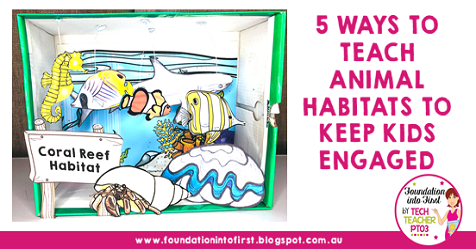Exploring animal habitats is one of those engaging elements of the curriculum and is actually fun to teach. Students love learning about new creatures and it's one of those teaching units where you can hear students saying "Cool!' - how often does that happen in your classroom?
Recently we started a study on animal habitats and as we live Queensland I thought, why not study creatures that inhabit the reef? I know my students would love learning about sharks and clownfish (Finding Nemo anybody?). Lots and lots to explore... so here are the little tips I did to keep the learning fun while still achieving learning goals.
Connections to the curriculum:
ACARA Year 1 Science
- Living things and basic needs including food and water
- Living things live in different places where their needs are met
1. First, we made sure we had a good solid understanding of the word 'habitat' and then built up some keywords on our learning wall for 'shelter', 'predator', 'burrow' and 'hollow'. The time you spend unpacking these words will help your students build upon that knowledge as your lesson progresses.
2. Next, we watched a video on the Great Barrier Reef and aimed to answer the question 'what is a reef?' with the help of a worksheet containing definitions of the different types of reefs.
3. After that, I divided the class into groups and gave them one creature each to study. However, as the shark was everybody's favourite we did that one first as a 'we do' example. We studied the fact sheet for the Whitetip Reef Shark and looked at some pictures. Then each group took one of the remaining sea creature each and did a group read of the fact sheet.
4. Each student then completed a recording sheet on their animal and the groups presented their findings to the whole class. We used the slides to show the class what each animal looked like and discussed their findings.
5. Lastly, students put their own diorama together. Each student brought in an old shoe box and we used the templates to cut out the creatures and place them into the box, remember first to paint the background (or use the background sheet if you want to reuse them). We used fishing wire to hang the fish in place and used bluetak on each end because we needed to keep reposititioning them (plus it means we can use the box again by not making holes in it). This was THE most exciting part of the lesson and students love hands-on activities to demonstrate their learning.
All the material for this activity can be found in my TpT store or over on my website.











No comments
Note: only a member of this blog may post a comment.